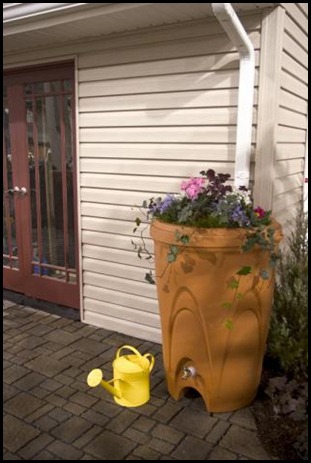Collecting Rain Water
What are the benefits?
Can you believe all this rain we have been getting this year? It has been one wet Spring and the Summer seems to not be much different.
What can you do with all this rain water that is saturating the areas around our downspouts?
We came across a great article that was featured in the Deseret News on May 7th, 2011, that introduced us to Rain Barrels – water conservation! Since most of us all have gardens, lawns and flowerbeds, this article by Joe Lampil, host of “Growing a Greener World” on PBS would be of great interest to all of you.
“By collecting rain from your roof during wet months and storing it in barrels or tanks, you can create an alternative supply to keep the landscape green without depending on municipal water. Rainwater doesn’t have the chemicals found in city water, either. It’s perfect for lawns, flowerbeds and vegetable gardens.
Collectors can be as simple as a rain gutter, downspout and barrel. There are complete kits available from garden-supply stores, catalogs and the internet, but you can make your own with just a few simple components. Before getting started, always check local building codes to be sure that rain-collection systems are approved in your area.
- First, install a wire-mesh or plastic gutter screen where the vertical downspout joins the horizontal gutter. This will help keep roof debris out of the system.
- Next, select a collection barrel. Gardening stores sell 55-75 gallon plastic rain barrels, complete with leaf screens and spouts, for $50 to $250. If you use a recycled barrel, select one that’s been used for food storage rather than any kind of chemical.
- For safety, barrels must have a sturdy cover that can take the weight of a child who might climb on it. To keep out mosquitoes and small animals, screen any openings. During winter months, barrels should be drained or kept only three-quarters full to allow freezing water to expand.
- Install a heavy-duty plastic drain spigot that can be “welded” into the barrel wall with waterproof plastic cement. Select one with common-size threads that can attach to an ordinary garden hose, and locate it as low as possible on the side of the barrel. Place the barrel on a raised platform to make room under the spigot for a watering can or hose attachment, and you’re ready to water.
You could harvest about 500 gallons of water off a typical 1,000 square foot roof in a storm that produced even 1 inch of rain. So what to do after the barrels are all full? Divert the rest of the water into a rain garden.
A rain garden is just a deep depression that collects runoff from impervious surfaces like roofs and driveways and lets it soak slowly into the ground. they’re planted with shrubs and perennials and maintained like any other landscaped are of your yard. Place the garden at least 10 feet from the foundation, and no more that 30 feet from the downspout. Avoid wells, septic systems and low areas that always seem wet.
A typical rain garden needs about 75 to 100 square feet of collecting area, so plan on a 10 by 8 foot flat bottomed bowl 6 inches deep. The bottom should be fairly level, and the sides gently sloped. Use the dugout soil to make a retaining berm on the downhill side of a sloped area.”


No comments:
Post a Comment